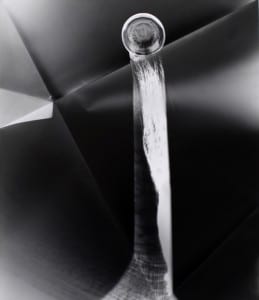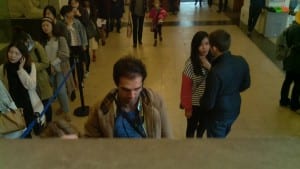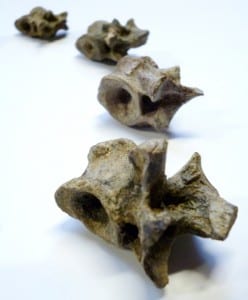Letting things draw themselves
By Jack Ashby, on 4 December 2015
This is a guest post from our artist in residence Eleanor Morgan. It is part of a series exploring the exhibition Glass Delusions at the Grant Museum of Zoology.
During my artist’s residency at the Grant Museum I wanted to record the way light travels through the glass jars and specimens that fill the space. My first thought was to try cyanotypes. This is a type of contact print in which an object is place on paper and exposed to light. Where the light hits, the resulting image is a deep blue colour. The astronomer John Herschel developed cyanotypes in the nineteenth century for creating blueprints of diagrams and notes, but it is the cyanotypes of his contemporary Anna Atkins that are particularly celebrated. By placing seaweeds and ferns on prepared paper, Atkins’ cyanotypes are beautifully detailed and create a sculptural effect on the paper.
The Evils Of Helium Balloons…and why you shouldn’t use them this holiday season.
By Nick J Booth, on 3 December 2015
Tis the season to be Jolly! We’re into the time for celebrations, festive cheer and office parties, drinks, mince pies and holiday decorations. And yet using some of those decorations could have serious consequences for us in the future, I’m talking of course about the menace that is… helium filled balloons.
Helium and UCL have a long and entwined history. Sir William Ramsay first identified it on earth on March 26th, 1895, in his UCL lab (now an artist’s studio in the Slade School of Art) and it was this, along with his discovery of argon, neon, krypton and xenon, that won him the Nobel Prize for Chemistry in 1904. There’s a couple of labs named after him, and arguably without him our neighbouring area of Soho would look very different (as helium is used in ‘Neon’ signs). Read the rest of this entry »
When your head is made of glass
By Jack Ashby, on 2 December 2015
This is a guest post from our artist in residence Eleanor Morgan. It is part of a series exploring the exhibition Glass Delusions at the Grant Museum of Zoology.
My current exhibition ‘Glass Delusions’ is about things transformed from living to non-living materials and back again. One of the ideas that particularly interested me was the history of humans believing that they were made of glass, a disorder known as the ‘glass delusion’ that I describe in a previous blog post. Those suffering from glass delusion believed that their heads were made of glass and could shatter at the slightest touch.
In the exhibition are various heads, glassy or shattered. On one wall is an antique fragment of leaded glass of a figure bending down. His hand is outstretched and he seems to stroke at the ground beneath his feet. The stained glass panel where his head should be is missing, only the lead outline remains. Read the rest of this entry »
Underwhelming Fossil Fish of the Month: November 2015
By Mark Carnall, on 30 November 2015
The sound of mince pies is in the air. People with awful moustaches are getting a free pass this month. This can mean one of only two things. Either the annual conference of British Pie Awards and The Handlebar Club have booked the same conference venue* or it’s November. Delete as appropriate. What this may mean is that it isn’t October anymore, so it’s time to welcome you to another underwhelming fossil fish of the month, our monthly foray into the world of uninspiring fossil fish. UK museums have thousands if not hundreds of thousands of fossil fish in their collections and they get a hard time. They aren’t used in exhibitions, they don’t feature on lunchboxes, they aren’t the subject of Hollywood films.
Well, normally that is. This month, due to a mix up at the email sorting office, I’ve been wired a rather interesting and semi-famous fossil fish. You’ll probably instantly recognise it from the photo below. It’s going to be hard to play this one down, this one has been featured on stamps. I know, I’m going to get letters for highering standards. Read the rest of this entry »
Specimen of the Week 216: European Plaice
By Dean W Veall, on 30 November 2015
Hello dear Specimen of the Week readers, Dean Veall here. This week I shall be bringing you a very fishy (again) Specimen of the Week, how can I possibly top the three toothed pufferfish you may be asking yourself? Well, I believe I have for two very good reasons. Firstly the fish I have chosen is one of the asymmetrical marvels of the natural world. Secondly, has one of the most curmudgeonly comical faces of all animals (I challenge you to find me an animal that beats this specimen). And finally, has recently featured in the events that have accompained our Glass Delusions exhibition. This week’s Specimen of the Week is…..
Agriculture and War : Seeds and Death -what does it all mean ?
By ucwehpi, on 24 November 2015
In our continuing series to document the process behind next year’s exhibition in the Octagon, Mark Peter Wright and Helena Hunter were chosen to work with curators and academic researchers from UCL on this new exhibition led by Helen Pike, Public Programmer at The Petrie Museum. Mark is an artist and researcher working across sound, video, assemblage and performance and Helena’s practice spans performance, text and moving image. The blog offers a chance for ideas to be presented and hopefully engage comment and conversation !
“Is there a form of theory that can acknowledge a certain ‘thing-power’, that is, the irreducibility of objects to the human meanings or agendas they also embody?”
Jane Bennett, Agency, Nature and Emergent Properties: An Interview with Jane Bennett. Contemporary Political Theory 8, 90-105 (February 2009).
Throughout October and early November we did a tour of curators and their collections. First up was Alice Stevenson, curator of the Petrie Museum of Egyptian Archeology. We discussed the agricultural tools and equipment dating back thousands of years on display and how such items evidence the development of mechanistic technologies that began to enter and change landscapes and civilizations, both physically and psychologically. We’re interested in tracing cartographies around such material cultures: extending an appreciation of the “thing” outwards, towards broader relationships and speculative assemblages, and their political and ecological consequences. Interestingly, Petrie himself produced a book called “Tools and Weapons”, a detailed analysis of items from an Egyptian expedition in 1916 and which nests agriculture and war, seeds and death in close proximity.
Next was Prof. Simon Lewis from UCL Geography department. Simon is at the cutting edge of Anthropocene debates and with Prof. Mark Maslin co-authored the recent paper “Defining the Anthropocene” (March 2015, N. 519) for the influential Nature Journal. We discussed the difficulty of pinning this contingent epoch to a specific start time. Our conversations focused upon two of the “Golden Spikes” that Lewis and Maslin identify as geological specificities, or points of “origin”. One being 1610 at the point of the collision of old and new worlds by way of colonialism and trade, the other being 1964 as a result of increased levels of radioactivity produced through nuclear weapons testing.
Our heads now spinning, we visited Nick Booth, curator of the Geology collections. We were interested in drawing out connections between the earth and technology, primarily through rare earth minerals. These physical elements, mined from the earth, make up parts of our so-called “immaterial” culture such as phones and laptops. Along with rare earths and a host of other items including a Chirotherium fossil footprint and Sir William Ramsay’s original set of discharge tubes, we were drawn to a collection of micro fossils and the deceptively large impact they have in relation to oil exploration.
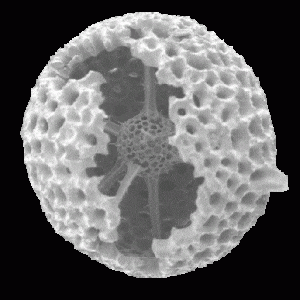
Close up of a micro fossil credit UCL Geology
Our final visit of the day took us to Paolo Viscardi, curator of the Grant Museum of Zoology. If the desire for energy drives the Anthropocene then it seems petroleum oil/plastics are one the central material actors within this story. Stemming from such materialities are the consequences on species such as the giant tortoises of the Galapagos. These animals were exploited for their oil rich bodies in addition to suffering from the clearance of their natural habitat for agricultural purposes. Like the microfossils these museum artefacts (in this case, giant shells) project a powerful grafting of non-humans and humans, technology and the earth, extinctions and possible futures.
To conclude this post, and in response to Jane Bennett’s opening quote at the top of this blog, we would say that although “thing-power” may productively recognize the intensities of material things in and of themselves, we are more interested in mixing vibrant matter with their geopolitical contexts: to drawn a cartography of consequences rather than a type of material awe.
Specimen of the week 215: the sparrowhawk taxidermy
By Will J Richard, on 23 November 2015
Hello zoo-fans. Will Richard here, throwing words at the page to bring you this specimen of the week. And what a specimen I’ve chosen. Graceful, elegant, deadly and now stuffed. Slightly wonkily. Case 17’s finest…
Read the rest of this entry »
Some More Favourite PanoptiCam Views
By Nick J Booth, on 19 November 2015
My last ‘Favourite PanoptiCam Views‘ blog post was way back in June, so an update is long overdue.
Summer is usually a quiet time for the auto-icon of Jeremy Bentham. There are less staff and students around and, although he does receive a regular stream of visitors, summer is often a time to pause and take stock of the past academic year. Infact it is very easy to forget just how busy UCL can be when the students return, however when the new academic year starts again…
Specimen of Week 214: Fossil Vertebrae
By Tannis Davidson, on 16 November 2015
In the spotlight this week is a specimen that is currently experiencing it’s ‘busy season’. The Grant Museum collection is widely used in teaching at UCL and the Museum is home to many specimen-based practicals. For example, during term 1 in 2014, there were 34 practicals using over 600 specimens by 1400 students.
Amidst this flurry of activity, certain specimens catch the eye. Is it that they are finally freed from the safe-keeping of their fossil drawers and have their moment to shine? Could it be that they are used over and over and over again to illustrate a turning point in evolution so critical that repeat viewings are essential? Or is it that the specimen is quite simply, an attractive object in itself, perhaps a worthy contestant in a specimen beauty contest?
This week’s Specimen of the Week is… Read the rest of this entry »
Where are we now?
By ucwehpi, on 10 November 2015
Mark Peter Wright and Helena Hunter were chosen to work with curators and academic researchers from UCL on this new exhibition project. Mark is an artist and researcher working across sound, video, assemblage and performance and Helena’s practice spans performance, text and moving image. In this series of blogs running from now until the exhibition opens, the two will discuss how they are finding the process of research and discuss the ideas that are emerging. The blog will stand in as the space of thinking for the exhibition
Helen Pike – Public Programmer
‘The fossils of the future are the ones we live among’.
Jussi Parikka, A Geology of Media, 2015, p.123
By Helena Hunter and Mark Peter Wright
As part of our research for the forthcoming Octagon exhibition we visited neuroscientists Aman Saleem and Matteo Carandini and at The Institute of Ophthalmology. We were introduced to methods and practices from their research that focused upon navigation and cognitive mapping. The main content of our discussions centred upon the ‘hippocampus’ – a region deep within the brain that resembles a seahorse. It plays a vital role in how both humans and mammals navigate through space, in addition to both short and long term memory function. As a multi-sensual area of the brain it differs from the visual cortex that has a more singular visual pursuit, offering a reception for sensory input that gives recognition but not clarity as to what we are seeing. The hippocampus is a plural, multi-sensory region in the brain accommodating a dualistic appreciation of place: the point we are physically located in and the place we may be relating to at a distance. Like the blue dot on Google maps, it resembles a pulsing area where the process and production of where we are, or think we are in the present is activated.
But where are we now?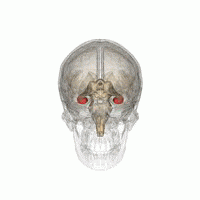 [1] This deceptively simple question has opened up many trajectories for us. Where are we in terms of physical space? Political or ecological contexts? Subjective and collective identities? What happens between the here and there when binaries collapse? What errors, frictions and fictions may emerge?
[1] This deceptively simple question has opened up many trajectories for us. Where are we in terms of physical space? Political or ecological contexts? Subjective and collective identities? What happens between the here and there when binaries collapse? What errors, frictions and fictions may emerge?
The Anthropocence is the current condition that underwrites such broad questioning of ‘where are we now?’ The term, coined by scientists, marks out a new geological epoch. It is an umbrella within which to describe how the human (antropos) has become irrecoverably grafted into every aspect of global-techno-animal life. Its consequences are read primarily through the current climate and ecological crisis. It also speaks towards the impact of advanced capitalism and our relationship to non-human agents – from animals to rocks. It is debated that we have been in this “now” since the industrial revolution, perhaps even further back. (See: Parikka, 2015). Alternative hybrid formations of the term, pinning specific areas of inquiry, have also been proposed (See: Braidotti ‘Capitaloscene’; Haraway ‘Chthulucene’; Parikka ‘Anthrobscene’).
[1] We are reluctant to speak of a “we” in terms of one homogenised collection of (human) people. When “we” is evoked we are therefore talking from our subjective and relational positions firstly, but also wish to extend a sense of collectivity and agency to non-human others.
 Close
Close


